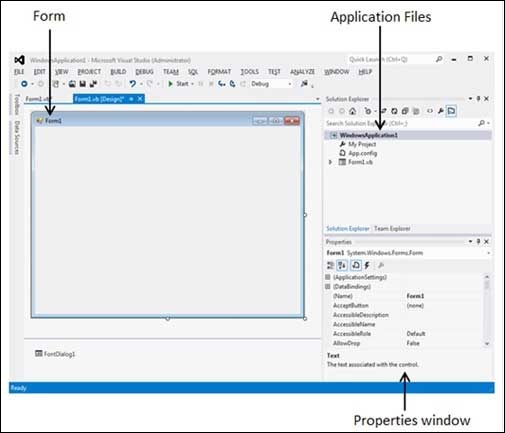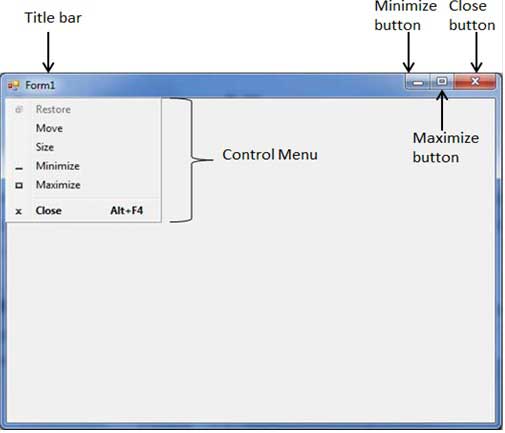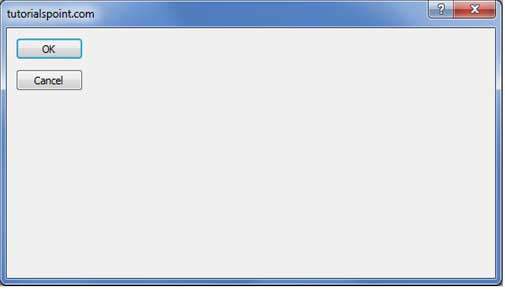Let's start with creating a Window Forms Application by following the following steps in Microsoft Visual Studio: File -> New Project -> Windows Forms Applications
Finally select OK, Microsoft Visual Studio your project and displays following window with a default Form with a name Form1.

Visual Basic Form is the container for all the controls that make up the user interface. Every window you see in a running visual basic application is a form, thus the terms form and window describe the same entity. Visual Studio creates a default form for you when you create a Windows Forms Application.
Every form will have title bar on which the form's caption is displayed and there will be buttons to close, maximize and minimize the form shown below:

If you click the icon on the top left corner, it opens the control menu, which contains the various commands to control the form like to move control from one place to another place, to maximize or minimize the form or to close the form.
Form Properties
Following table lists down various important properties related to a form. These properties can be set or read during application execution. You can refer to Microsoft documentation for a complete list of properties associated with a Form control:
| S.N | Properties | Description |
|---|---|---|
| 1 | AcceptButton | The button that's automatically activated when you press Enter, no matter which control has the focus at the time. Usually the OK button on a form is set as AcceptButton for a form. |
| 2 | CancelButton | The button that's automatically activated when you hit the Esc key. Usually the Cancel button on a form is set as CancelButton for a form. |
| 3 | AutoScale | This Boolean property determines whether the controls you place on the form are automatically scaled to the height of the current font. The default value of this property is True. This is a property of the form, but it affects the controls on the form. |
| 4 | AutoScroll | This Boolean property indicates whether scroll bars will be automatically attached to the form if it is resized to a point that not all its controls are visible. |
| 5 | AutoScrollMinSize | This property lets you specify the minimum size of the form, before the scroll bars are attached. |
| 6 | AutoScrollPosition | The AutoScrollPosition is the number of pixels by which the two scroll bars were displaced from their initial locations. |
| 7 | BackColor | Sets the form background color. |
| 8 | BorderStyle | The BorderStyle property determines the style of the form's border and the appearance of the form:
|
| 9 | ControlBox | By default this property is True and you can set it to False to hide the icon and disable the Control menu. |
| 10 | Enabled | If True, allows the form to respond to mouse and keyboard events; if False, disables form. |
| 11 | Font | This property specify font type, style, size |
| 12 | HelpButton | Determines whether a Help button should be displayed in the caption box of the form. |
| 13 | Height | This is the height of the Form in pixels. |
| 14 | MinimizeBox | By default this property is True and you can set it to False to hide the Minimize button on the title bar. |
| 15 | MaximizeBox | By default this property is True and you can set it to False to hide the Maximize button on the title bar. |
| 16 | MinimumSize | This specifies the minimum height and width of the window you can minimize. |
| 17 | MaximumSize | This specifies the maximum height and width of the window you maximize. |
| 18 | Name | This is the actual name of the form. |
| 19 | StartPosition | This property determines the initial position of the form when it's first displayed. It will have any of the following values:
|
| 20 | Text | The text which will appear at the title bar of the form. |
| 21 | Top, Left | These two properties set or return the coordinates of the form's top-left corner in pixels. |
| 22 | TopMost | This property is a True/False value that lets you specify whether the form will remain on top of all other forms in your application. Its default property is False. |
| 23 | Width | This is the width of the form in pixel. |
Form Methods
The following are some of the commonly used methods of the Form class.You can refer to Microsoft documentation for a complete list of methods associated with forms control:
| S.N. | Method Name & Description |
|---|---|
| 1 | Activate Activates the form and gives it focus. |
| 2 | ActivateMdiChild Activates the MDI child of a form. |
| 3 | AddOwnedForm Adds an owned form to this form. |
| 4 | BringToFront Brings the control to the front of the z-order. |
| 5 | CenterToParent Centers the position of the form within the bounds of the parent form. |
| 6 | CenterToScreen Centers the form on the current screen. |
| 7 | Close Closes the form. |
| 8 | Contains Retrieves a value indicating whether the specified control is a child of the control. |
| 9 | Focus Sets input focus to the control. |
| 10 | Hide Conceals the control from the user. |
| 11 | Refresh Forces the control to invalidate its client area and immediately redraw itself and any child controls. |
| 12 | Scale(SizeF) Scales the control and all child controls by the specified scaling factor. |
| 13 | ScaleControl Scales the location, size, padding, and margin of a control. |
| 14 | ScaleCore Performs scaling of the form. |
| 15 | Select Activates the control. |
| 16 | SendToBack Sends the control to the back of the z-order. |
| 17 | SetAutoScrollMargin Sets the size of the auto-scroll margins. |
| 18 | SetDesktopBounds Sets the bounds of the form in desktop coordinates. |
| 19 | SetDesktopLocation Sets the location of the form in desktop coordinates. |
| 20 | SetDisplayRectLocation Positions the display window to the specified value. |
| 21 | Show Displays the control to the user. |
| 22 | ShowDialog Shows the form as a modal dialog box. |
Form Events
Following table lists down various important events related to a form. You can refer to Microsoft documentation for a complete list of events associated with forms control:
| S.N | Event | Description |
|---|---|---|
| 1 | Activated | Occurs when the form is activated in code or by the user. |
| 2 | Click | Occurs when the form is clicked. |
| 3 | Closed | Occurs before the form is closed. |
| 4 | Closing | Occurs when the form is closing. |
| 5 | DoubleClick | Occurs when the form control is double-clicked. |
| 6 | DragDrop | Occurs when a drag-and-drop operation is completed. |
| 7 | Enter | Occurs when the form is entered. |
| 8 | GotFocus | Occurs when the form control receives focus. |
| 9 | HelpButtonClicked | Occurs when the Help button is clicked. |
| 10 | KeyDown | Occurs when a key is pressed while the form has focus. |
| 11 | KeyPress | Occurs when a key is pressed while the form has focus. |
| 12 | KeyUp | Occurs when a key is released while the form has focus. |
| 13 | Load | Occurs before a form is displayed for the first time. |
| 14 | LostFocus | Occurs when the form loses focus. |
| 15 | MouseDown | Occurs when the mouse pointer is over the form and a mouse button is pressed. |
| 16 | MouseEnter | Occurs when the mouse pointer enters the form. |
| 17 | MouseHover | Occurs when the mouse pointer rests on the form. |
| 18 | MouseLeave | Occurs when the mouse pointer leaves the form. |
| 19 | MouseMove | Occurs when the mouse pointer is moved over the form. |
| 20 | MouseUp | Occurs when the mouse pointer is over the form and a mouse button is released. |
| 21 | MouseWheel | Occurs when the mouse wheel moves while the control has focus. |
| 22 | Move | Occurs when the form is moved. |
| 23 | Resize | Occurs when the control is resized. |
| 24 | Scroll | Occurs when the user or code scrolls through the client area. |
| 25 | Shown | Occurs whenever the form is first displayed. |
| 26 | VisibleChanged | Occurs when the Visible property value changes. |
Example:
Following is an example which shows how we create two buttons at the time of form load event and different properties are being set at the same time.
Because Form1 is being referenced with-in its own event handler so it will be written as Me instead of using its name, but if we access the same form inside any other control's event handler then it will access using its name Form1.
Let's double click on the Form and put the follow code in the opened window.
Public Class Form1 Private Sub Form1_Load(sender As Object, e As EventArgs) Handles MyBase.Load ' Create two buttons to use as the accept and cancel buttons. Dim button1 As New Button() Dim button2 As New Button() ' Set the text of button1 to "OK". button1.Text = "OK" ' Set the position of the button on the form. button1.Location = New Point(10, 10) ' Set the text of button2 to "Cancel". button2.Text = "Cancel" ' Set the position of the button based on the location of button1. button2.Location = _ New Point(button1.Left, button1.Height + button1.Top + 10) ' Set the caption bar text of the form. Me.Text = "tutorialspoint.com" ' Display a help button on the form. Me.HelpButton = True ' Define the border style of the form to a dialog box. Me.FormBorderStyle = FormBorderStyle.FixedDialog ' Set the MaximizeBox to false to remove the maximize box. Me.MaximizeBox = False ' Set the MinimizeBox to false to remove the minimize box. Me.MinimizeBox = False ' Set the accept button of the form to button1. Me.AcceptButton = button1 ' Set the cancel button of the form to button2. Me.CancelButton = button2 ' Set the start position of the form to the center of the screen. Me.StartPosition = FormStartPosition.CenterScreen ' Set window width and height Me.Height = 300 Me.Width = 560 ' Add button1 to the form. Me.Controls.Add(button1) ' Add button2 to the form. Me.Controls.Add(button2) End Sub End Class
When the above code is executed and run using Start button available at the Microsoft Visual Studio tool bar, it will show following window:

No comments:
Post a Comment